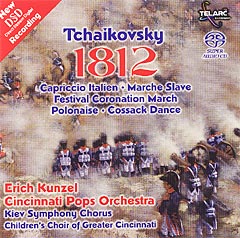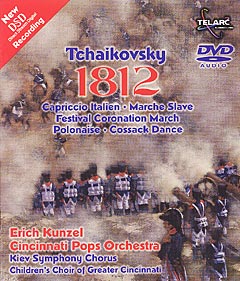Home Page |
About Me |
Home Entertainment |
Home Entertainment Blog |
Politics |
Australian Libertarian Society Blog |
Disclosures
A Letter to Telarc Concerning Telarc's 'Height' Channel
This version: 7 July 2003. This is the text of an email originally written on 10 November 2001 to Michael Bishop of Telarc, the audiophile recording company in the United States. Aside from an acknowledgement of receipt, the email has never been answered. It seems to me that Telarc's use of the multi-channel capabilities of DVD-A and SACD is misguided. Read on to see why.
Hi Michael
I guess I'm your person to contact. Feel free to email or call.
Thanks very much for getting back to me. May I say at the outset that I feel very privileged to be corresponding with you directly. I admire your work very much, not just Telarc's in general but yours personally. I had fully expected to get the usual PR person or, at best, a fairly low-level engineer!

|
|
CD cover
|
As I mentioned, I'm planning to put together an article on the various new surround formats, with an emphasis on the non-lossy compressed versions: SACD which utilises DSD and DVD-A which uses MLP. I should mention, since I don't imagine you read many Australian periodicals, that I am a full-time freelance writer on audio equipment and technology. I primarily do reviews of home entertainment equipment, plus audio-related computer peripherals and software (but I also review mobile phones, digital cameras, notebook computers and the like). Around 700 of my articles have appeared in a wide range of Australian publications over the past five years, including Australia's leading Hi Fi magazine, Australian HI-FI.
So, enough of patting myself on the back.
With a view to doing this SACD vs DVD-A (and a subsidiary look at DTS and Dolby Digital, plus the reference standard of CD) piece, I have aquired copies of the new 1812 Overture issued by Telarc in the CD, SACD and DVD-A formats. I understand that you were primarily responsible for engineering this release. While I haven't yet undertaken particularly critical listening, may I compliment you on the general excellence of the recording?
My particular queries, though, are in two areas. The first concerns the comparability of the different formats. I have previously published a similar comparison on standard CD vs a 96kHz/24 bit PCM CD, based on Chesky discs. Chesky was kind enough to assure me that this recording was originally made using the standards which appeared on the DVD, namely 96/24, and that the only difference in the CD version was the downsampling of the source to 44.1/16.

|
|
SACD cover
|
So I wonder if there are any differences between the different formats of the 1812 recording other, obviously, than the 2/6 channel differences? In particular, are the six channel DVD-A and SACD (and DTS) versions identical in all respects other than the particular digital format used to carry the data? And are the two channel versions on each likewise identical to the CD version, once again apart from the digital data format?
Would you also be able to confirm for me that the following delivery standards have been used on the different media?
-
Telarc Stereo CD-80541: Standard CD (PCM 44.1/16)
-
Telarc Surround SACD-60541: Hybrid SACD with PCM 44.1/16 on the CD layer, 6 channel DSD surround* and 2 channel DSD on the SACD layer
-
Telarc Surround DVDA-70541: Double sided DVD.
- Side 1: DVD Audio: 88.2kHz/20 bit surround* and 88.2kHz/24 bit stereo
- Side 2: DVD Video with DTS surround (5.0, 1509kb/s) and 48kHz/16 bit PCM stereo (1536kb/s), plus PC content including all the tracks in 128kb/s MP3
Contrary to what the cover of the DVD-A says, there seems to be effectively no 'Dolby Audio' sound track on the DVD Video side of the disc. (There are actually two audio tracks listed on the disc when playing back the DTS sound track. The first one is the DTS track and the second is Dolby Digital 2.0 at 192kb/s. But the latter only lasts for 30 seconds and then stops. In any case, it is subject to a User Operation Prohibition so unmodified DVD players cannot access it.)

|
|
DVD-Audio cover
|
My second query relates to the asterisks on the standards above, which follows from a suggestion in the booklets in the two multichannel versions that Telarc is dispensing with the LFE channel, using this instead for 'height' information.
Apparently you're supposed to set up your receiver to manage the bass from the 5 main tracks, sending it to the subwoofer, and take a separate feed from the 0.1 output on the SACD/DVD Audio player, feed it to an amp and thence to an additional pair of speakers located up near the ceiling on the sides of the room.
This seems an odd thing to do.
First, assuming the consumer would concern him or herself with additional amplification and speakers for titles from just one label, and assuming that the system worked, it means a great deal of cable swapping, depending upon whether a standard DVD-A or DVD-V or SACD, or one of Telarc's 'height' versions, is to be played.
Second, it assumes that the LFE output on the SACD/DVD-A player will not have some kind of low pass filtering built in.
Third, it is difficult for the consumer to adjust the volume level of the 'height' signal in sync with system-wide volume changes. You can't feed the height signal through the LFE channel of a conventional receiver on the off-chance that it does have some bass management which filters out everything above 80 or 120 hertz (although most receivers typically do nothing to the signal through the LFE channel). Safer would be feeding the signal through the centre rear channel of the newer 6.1 channel receivers.
 Fourth, when using six channel input from an external decoder (or DVD-A/SACD player), the great majority of home theatre receivers do not manage bass at all. They leave that to the source device. Instead, they do nothing to this signal other than control the level and, perhaps, allow channel level balancing. So the bass management in the receiver cannot be relied upon -- there is none. (I have checked this with Marantz, Denon, Onkyo, Yamaha, Harman Kardon and Sony receivers with 5.1 channel inputs. None of these manage bass on this input.)
Fourth, when using six channel input from an external decoder (or DVD-A/SACD player), the great majority of home theatre receivers do not manage bass at all. They leave that to the source device. Instead, they do nothing to this signal other than control the level and, perhaps, allow channel level balancing. So the bass management in the receiver cannot be relied upon -- there is none. (I have checked this with Marantz, Denon, Onkyo, Yamaha, Harman Kardon and Sony receivers with 5.1 channel inputs. None of these manage bass on this input.)
Fifth, to invoke the bass management facilities (ie. to route the bass to the subwoofer) on a consumer DVD-A/SACD player, the player has to be instructed that the user has a subwoofer connected. If the player is so instructed, one of two things happen:
-
if the other speakers in the system are set to 'large', only the 'LFE' signal ('height' signal) in this SACD's case will be sent to the 'subwoofer' channel (and can thus be used for feeding the 'height' speakers, but this means no bass is available for the subwoofer, and if the speakers are small, no bass is available at all!)
-
but, if one or more of the other speakers in the system are set to 'small', then both the 'LFE' (height) and bass from those channels will be sent to the subwoofer channel.
To check this, I grabbed a few seconds of analogue output from the LFE output of a Sony DVP-NS900V SACD/DVD-V player on the second track of the multichannel SACD version, with the centre and surround speakers set to 'small' (probably the most common setup). The resulting signal had most of its energy in the 50 to 200 hertz region. From 150 hertz and up it rolled off at 18dB per octave. For one of the cannon shots towards the end of the first track, the signal was within + or - 6dB from 10 hertz (!) to 110 hertz, then rolled off at around the same rate. It looked suspiciously like the height information was having the bass from the 'small' centre and surround speakers folded into it. Repeating with all the speakers set to 'large' got rid of most of the bass (this cannot be relied on, though, since equipment engineers sometimes design the system to send some of the other channels' bass to the subwoofer channel, regardless of the speaker size setting -- and it is not obvious from the equipment instructions whether or not this is the case). Most of the 'LFE' signal content on that setting was in the 90 to 3,700 hertz region, which I imagine is what you intend for the height channel.
So, is Telarc is aware of these issues that would impact adversely on the use of the 'height' channel? It seems that the only way to confidently implement the system would be to use custom designed electronics.
Sorry that this turned out to be so long! But, as you can see, it is quite a complex issue.
© 2001 by Stephen Dawson




 Fourth, when using six channel input from an external decoder (or DVD-A/SACD player), the great majority of home theatre receivers do not manage bass at all. They leave that to the source device. Instead, they do nothing to this signal other than control the level and, perhaps, allow channel level balancing. So the bass management in the receiver cannot be relied upon -- there is none. (I have checked this with Marantz, Denon, Onkyo, Yamaha, Harman Kardon and Sony receivers with 5.1 channel inputs. None of these manage bass on this input.)
Fourth, when using six channel input from an external decoder (or DVD-A/SACD player), the great majority of home theatre receivers do not manage bass at all. They leave that to the source device. Instead, they do nothing to this signal other than control the level and, perhaps, allow channel level balancing. So the bass management in the receiver cannot be relied upon -- there is none. (I have checked this with Marantz, Denon, Onkyo, Yamaha, Harman Kardon and Sony receivers with 5.1 channel inputs. None of these manage bass on this input.)